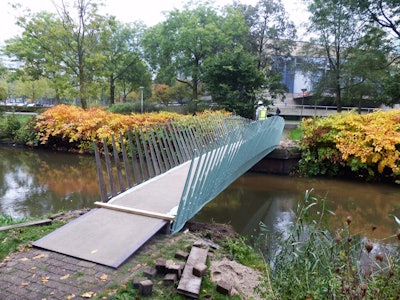
Dutch students in the Netherlands have built a 46-foot-long footbridge out of hemp and flax fibers to demonstrate a use of more sustainable construction materials. Known as the "biobridge" the project was the result of a partnership between TU Delft, Eindhoven University of Technology (TU/e), University of Twente and University of Wageningen.
Hemp and flax were chosen because they are abundantly available. The hemp and flax fibers are stuck to a polylactic acid foam core which has a low density and is biodegradable and compostable. Once the fibers are in place, a vacuum sucks bioresin into the fiber layers to create the biocomposite. The bioresin hardens and binds the fibers together.
"Using biocomposite in constructions reduces our dependence on finite fossil resources and brings us a step closer to the circular economy in which products and resources are reused," says TU/e researcher and project leader Rijk Blok. "In time, I expect that we will see more of these materials in our buildings."
Biomaterials have been used for construction in the past, but they have not yet been used to create load-bearing structures. The biobridge will be in place for a year, and could be expected to have a lifespan of two years at the very least.
There are 28 sensors embedded in the bridge that will be used to measure strain and bending. This data will be relayed to the project team in real-time and data on factors like temperature, moisture and UV light exposure will also be monitored.
















